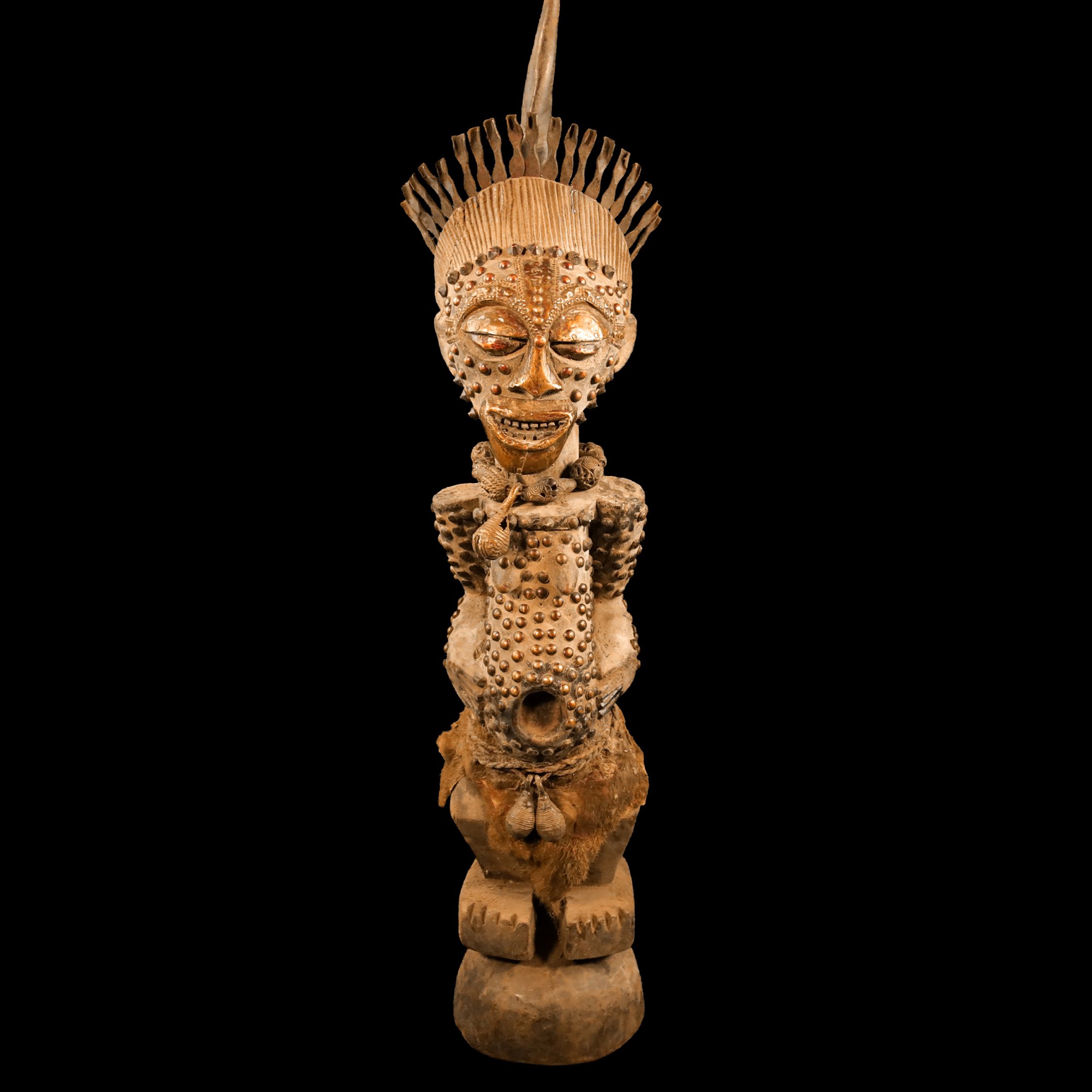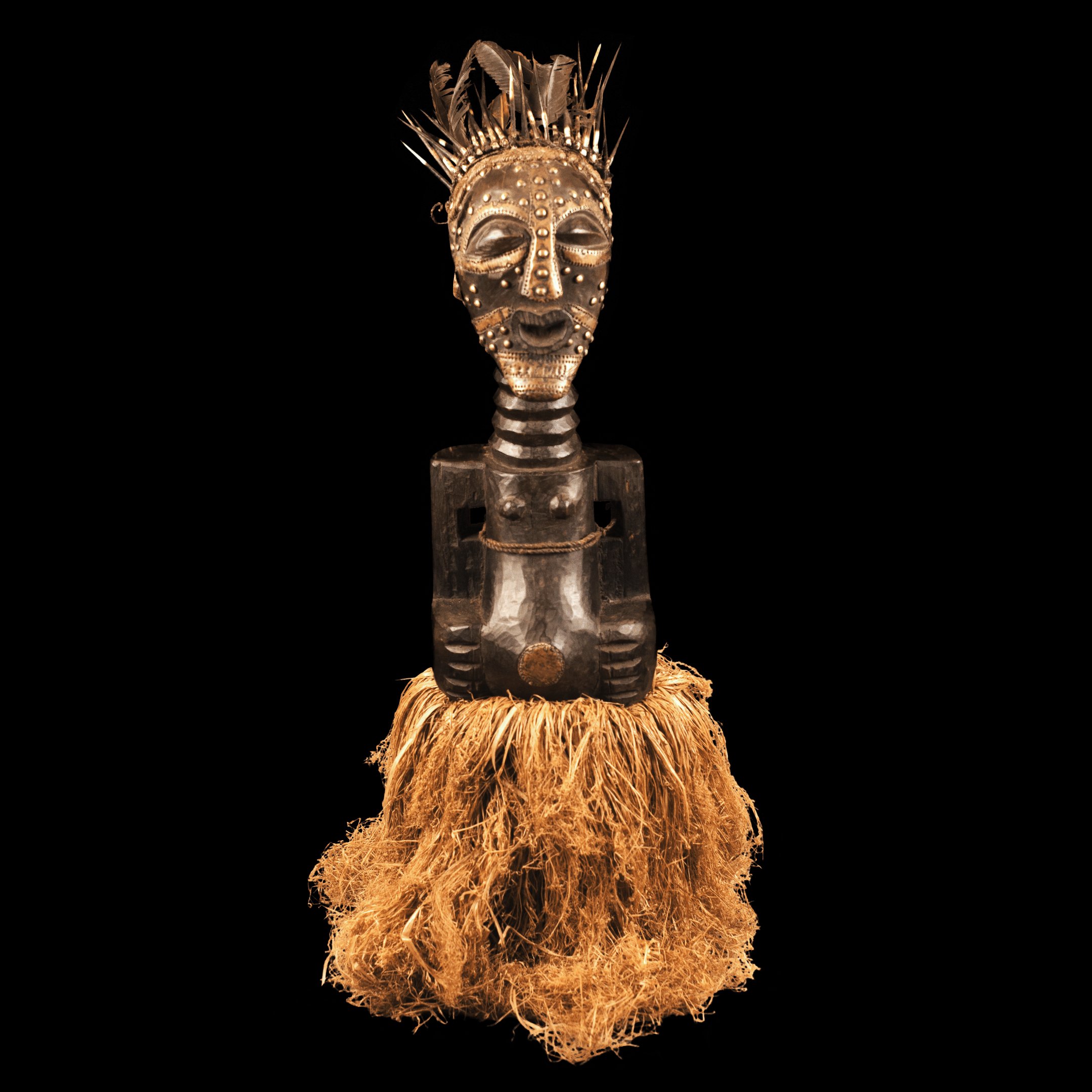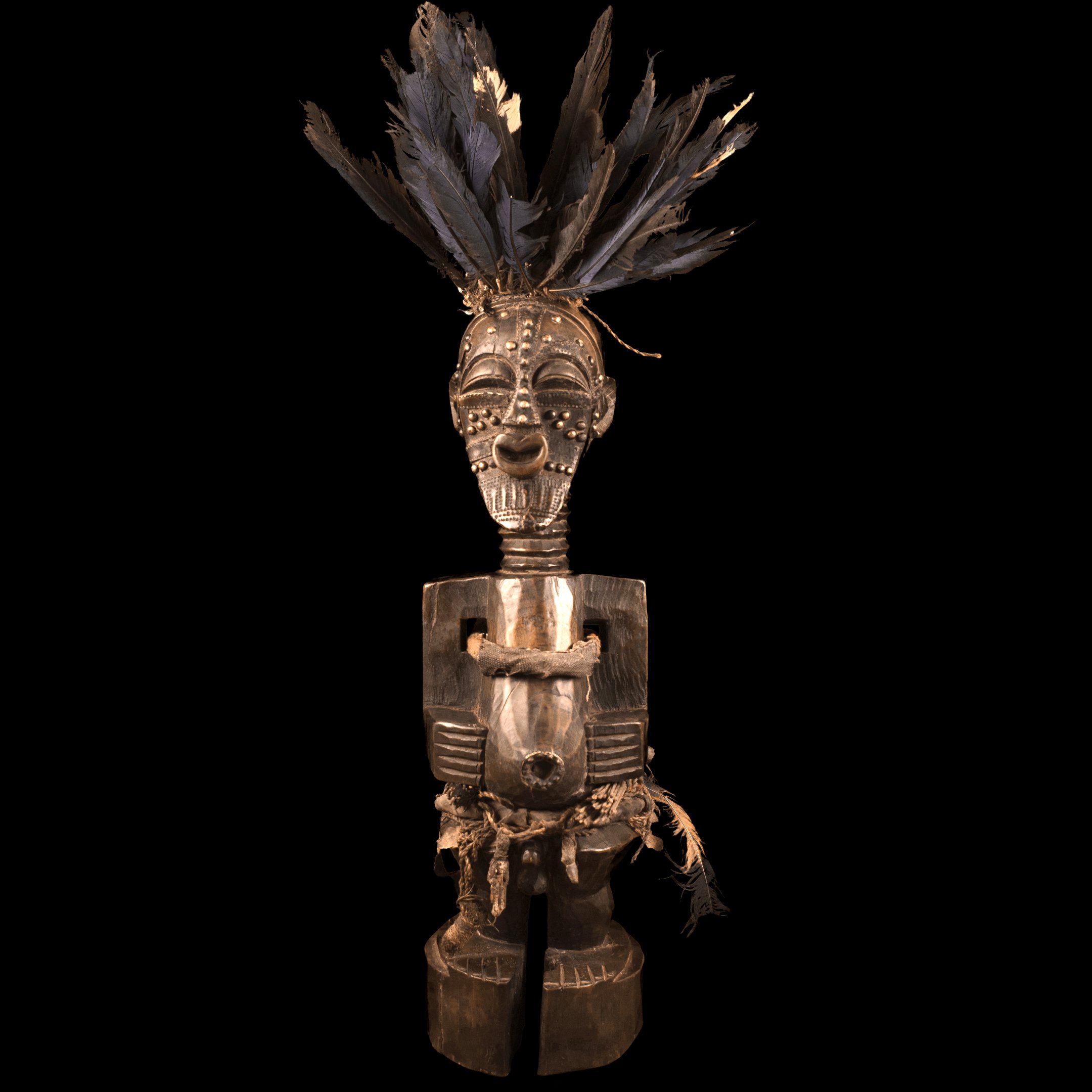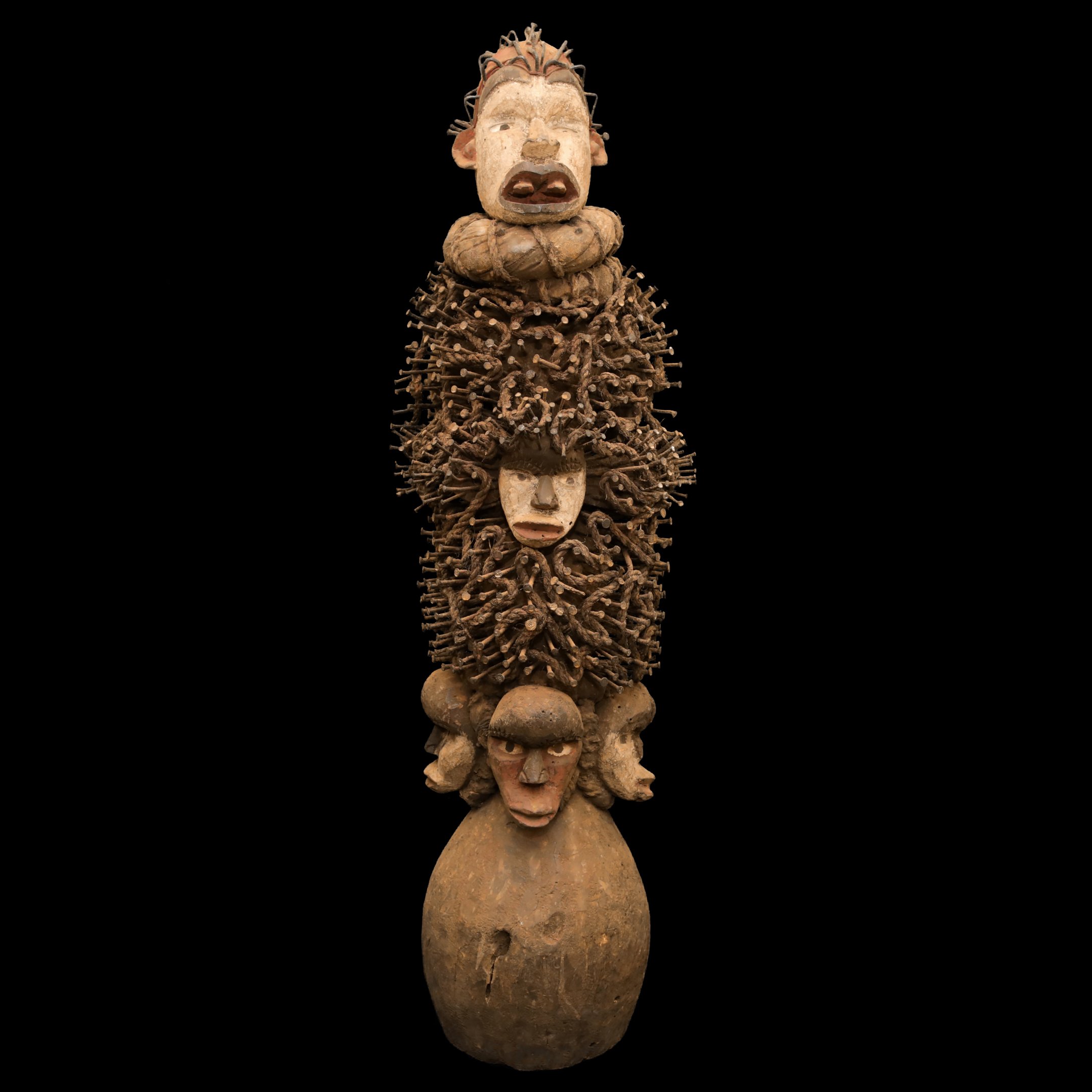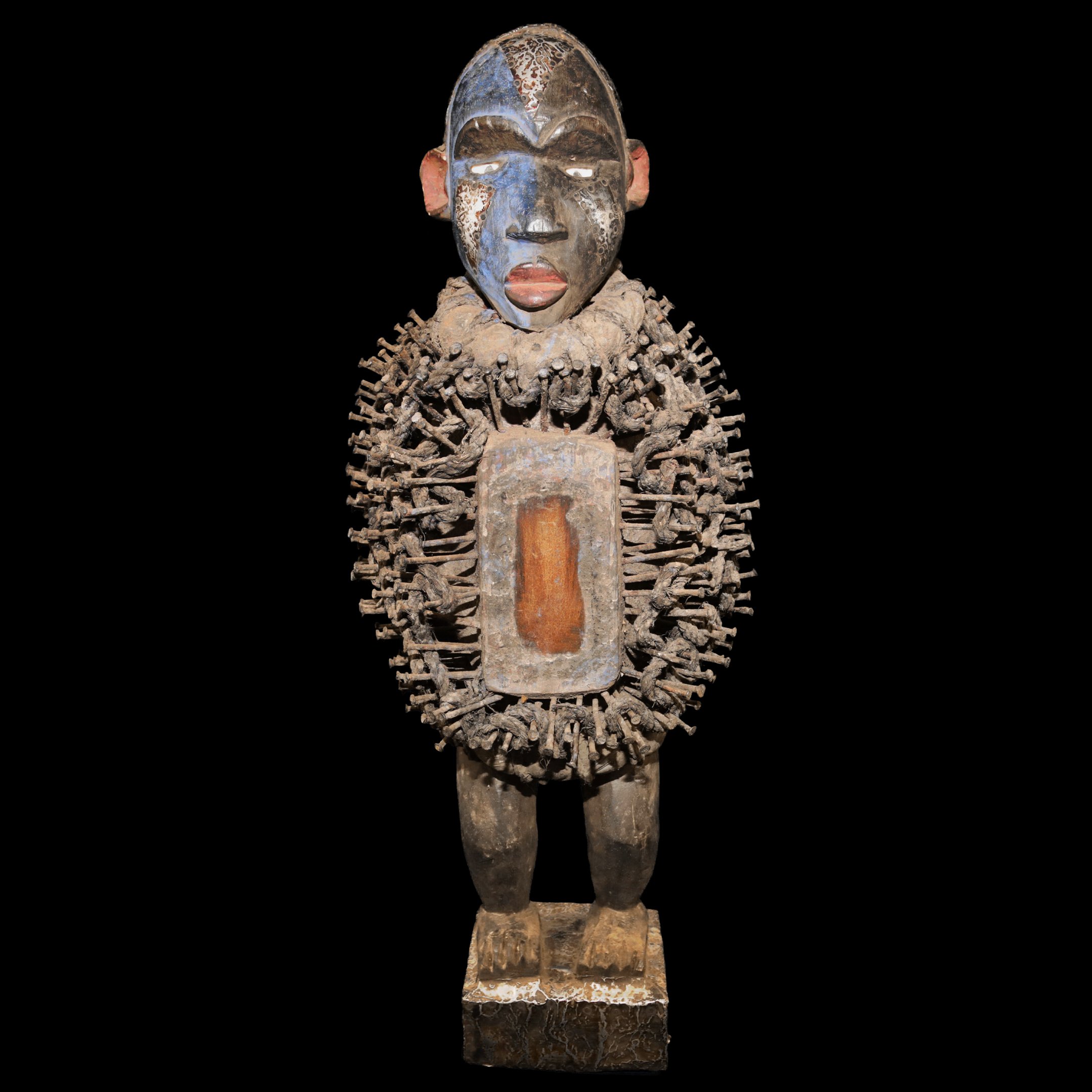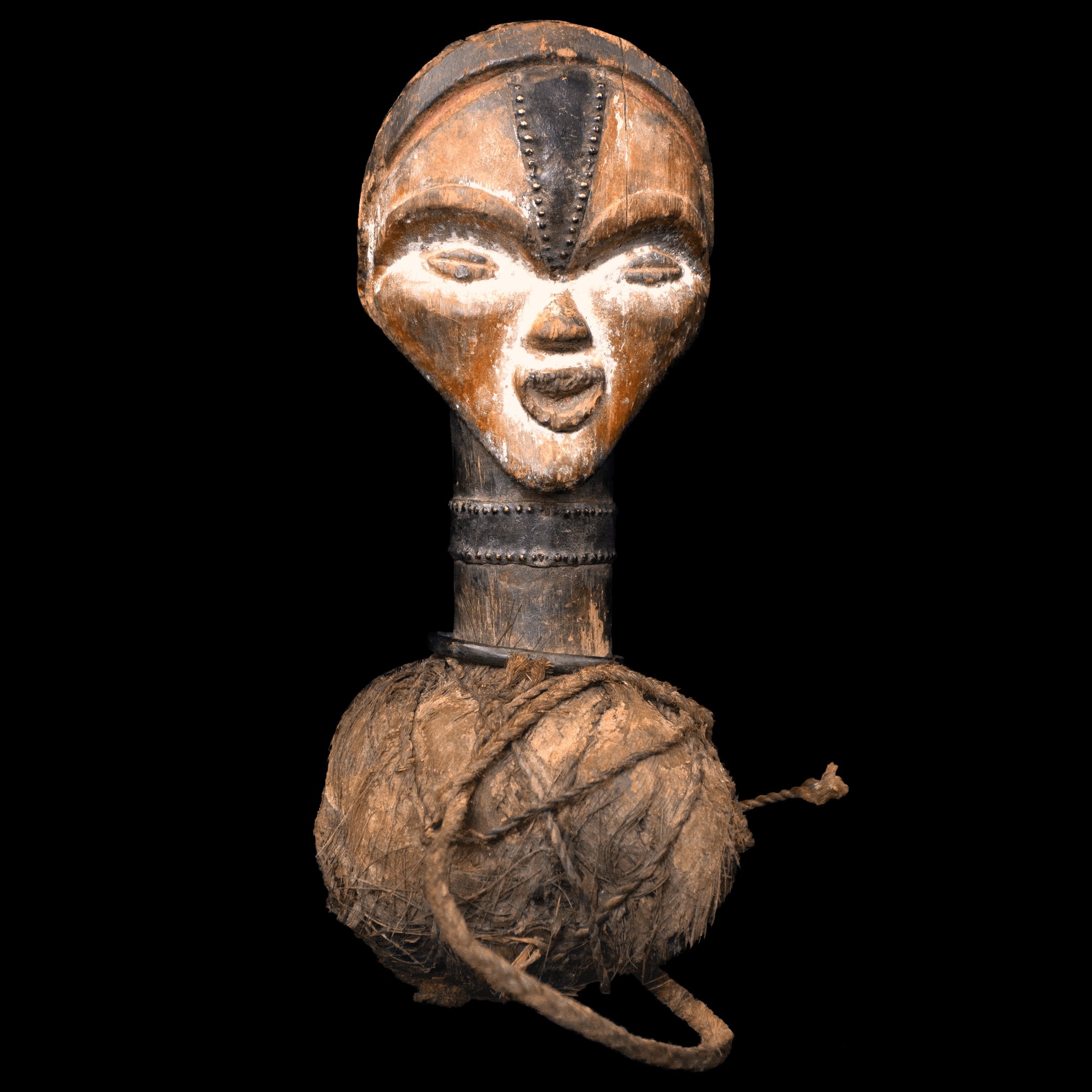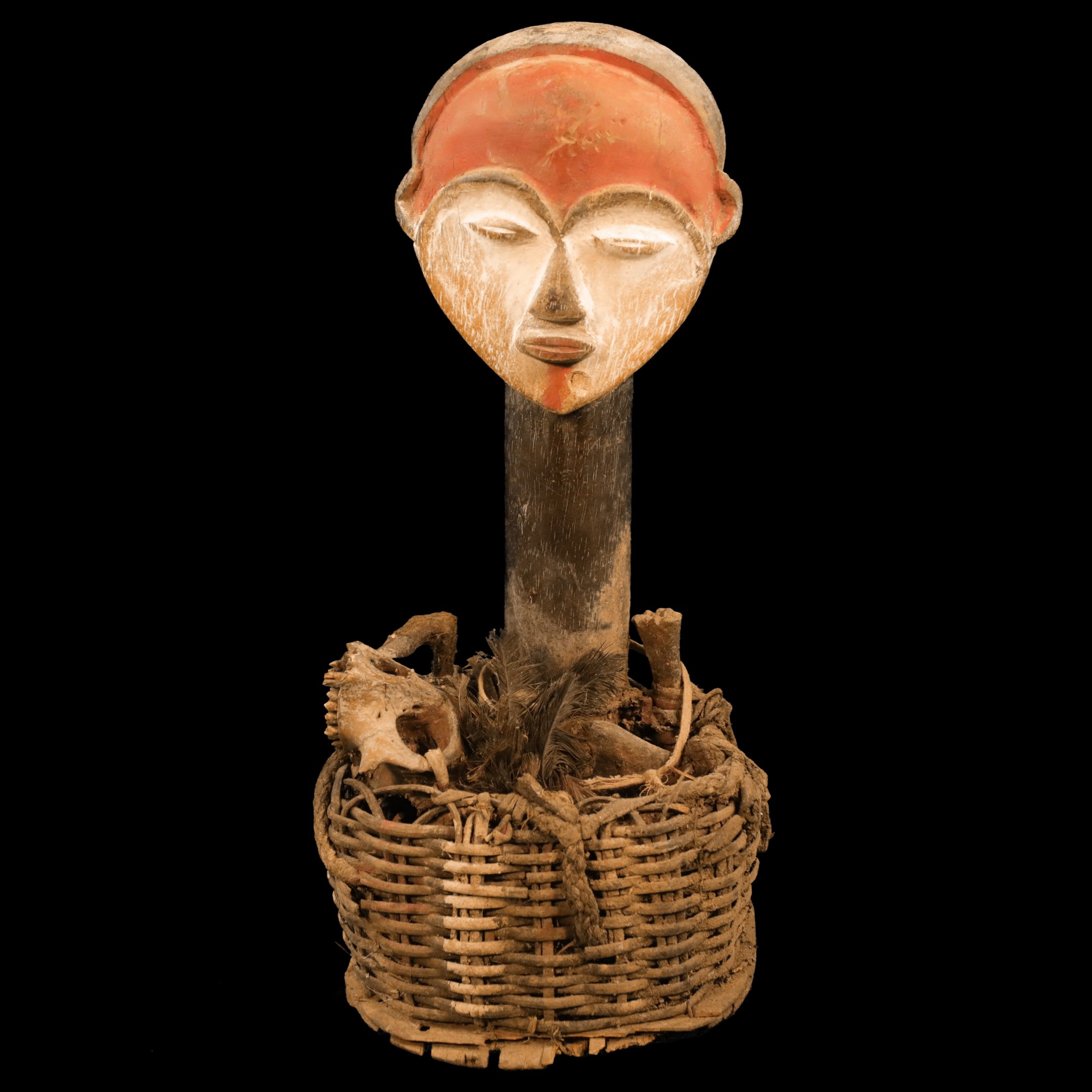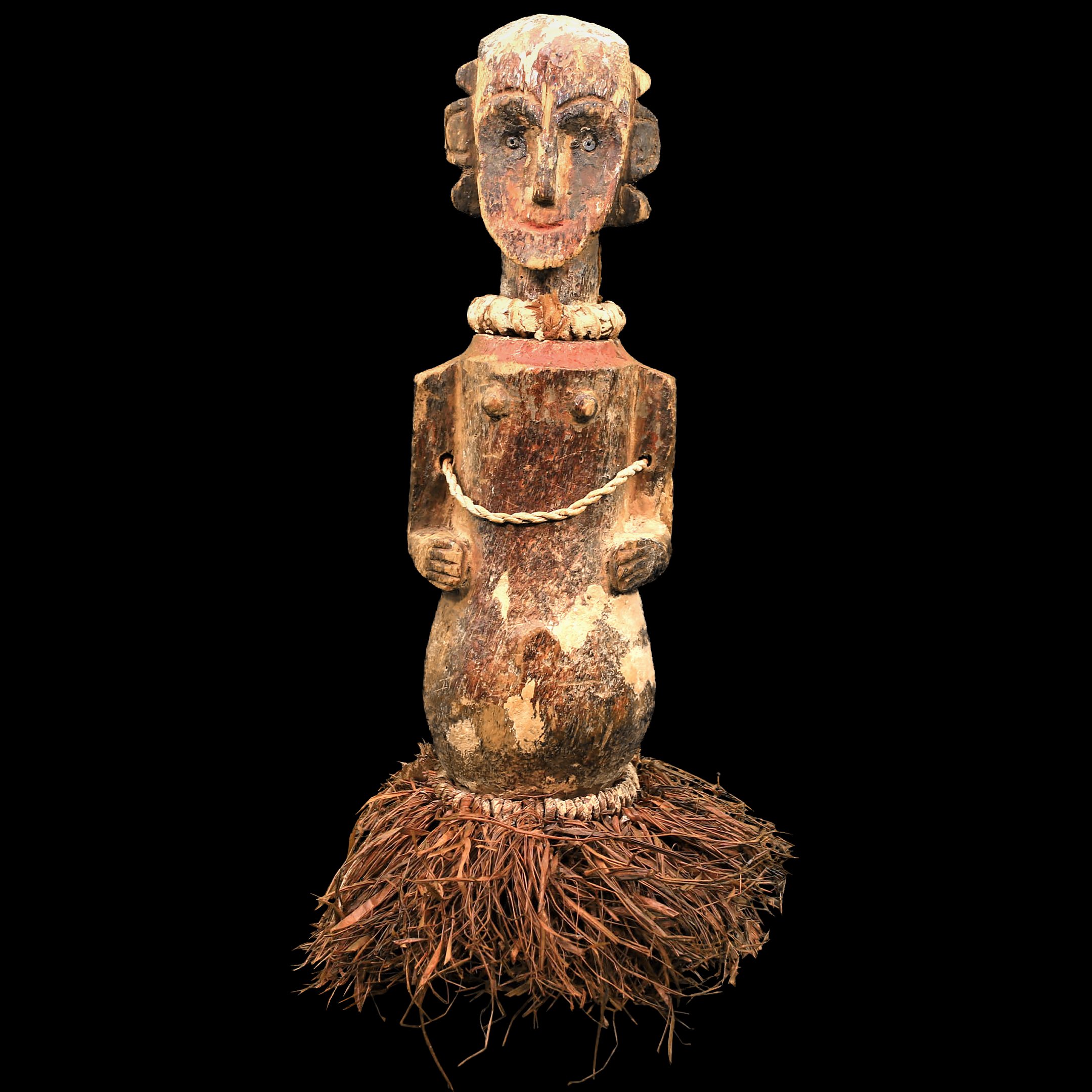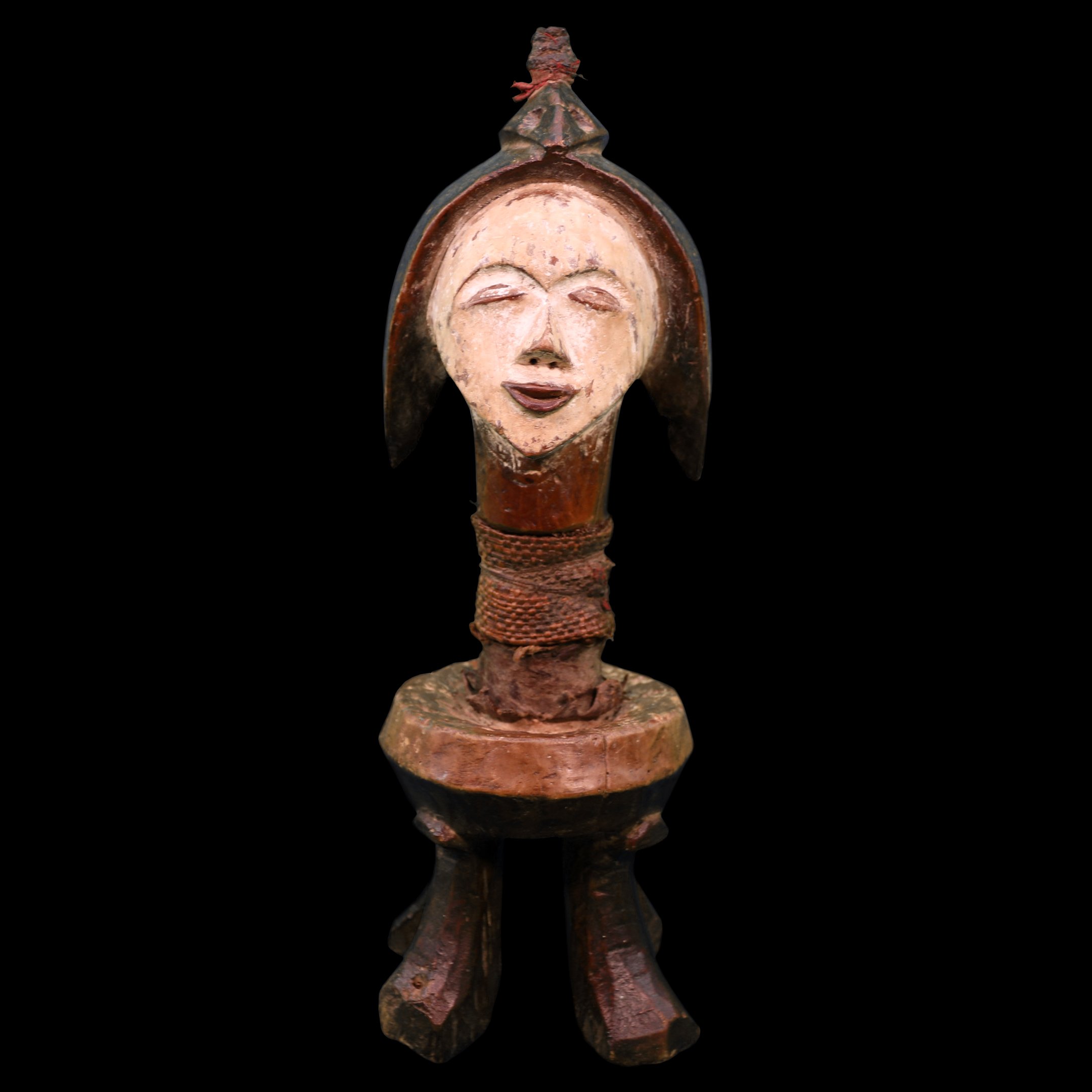Members of a secret society in a Grasslands village.
Bamileke spiritual master, capable of becoming an animal, then reverting again to human form.
Priest, Malela Kasai Basin, Kongo.
Sacred sight for trophies commemorating defeated or fallen worriers.
A Teke tribesman in southeastern Congo accompanied by minkisi.
Between Two Worlds presents images of over 20 spiritual objects, called minkisi (sing. nkisi). These spiritual artifacts played a central role in the African cosmology, or belief system, among Bantu tribes stretching from present-day Angola northward through the now-Democratic Republic of Congo, the Republic of Congo, Gabon, Equatorial Guinea, and into central Cameroon. Similar belief systems prevailed in tribes and kingdoms along the coast of West Africa from Nigeria to the Senegambia, reaching inland hundreds of miles.
Minkisi were the spiritual objects that linked the two parallel worlds in African cosmology, the land of the living and the land of the dead. These worlds—though essentially separate—overlapped, interacted, and communicated with each other, in a perpetual give-and-take of balance and rebalance. Minkisi contained spiritual power drawn from the land of the dead to influence the behavior of people in the land of the living. Those spiritual powers were either beneficial or detrimental.
Only a specially trained spiritual practitioner, called an nganga (pl. banganga), could access the power of the dead and translate that power into an nkisi, the spiritual vehicle capable of influencing the behavior of the living. The banganga were the living’s interlocutors with ancestral spirits, who, as custodians of tribal law and morality, had the power to punish or reward. They were also central to maintaining social harmony. Spiritual guides included: chiefs, who provided village stability and justice; diviners, who could foretell the future; spirit operators, who could embed the power of the dead in material objects; and witches, or evildoers. In the context of this belief system, it was only natural that the spiritually powerful should be at the center of a tribe or kingdom’s decision-making and civil justice.
Banganga could embed this spiritual power in figurines of wood or clay, wrapped cloth bundles, body accouterments, gourds, reliquaries, or any number of mundane items. Villagers carried these objects—the minkisi—on their bodies, hid them in huts and storage bins, or positioned them in key places around the village to protect all who lived there.
Some banganga specialized in treating certain ailments, such as infertility or digestive problems while, for example, other healers along the great Congo River provided spiritual charms to protect traders and porters as they crossed tribal lines up and down that riverine trade route. Some banganga specialized in taming the spirits of various animals—snakes, crocodiles, monkeys, or birds—who could serve as villager protectors. On the other hand, witches could draw evil spirits from the land of the dead to disrupt, damage or even kill the living. In African cosmology, misfortune was not an accidental occurrence: it was the direct result of an evil spirit drawn from the land of the dead to damage a family member, neighbor or competitor.
Constructing an nkisi and activating the spirits of the dead was a highly specialized process that began with selecting the proper wood stock, shaping it into human or otherwise anthropomorphic form, and collecting personal articles to be attached to the wooden base. An nganga prepared a special “medicine pack,” which would be inserted in the nkisi’s stomach or into cavities in ears, eyes, back, groin, or other body parts. These sealed medicine packs contained minerals, gunpowder, bones, figurines, or other essences prescribed by the healer to provide the spiritual power to fulfill the nkisi’s mission. However, the nkisi could not come to life until the soliciting client or group of villagers had activated the spirits by driving nails, blades, and bolts directly into its body. Songs, incantations, and invocations completed the activation of the spirits of the dead, who would thereafter devote themselves to defending the living who had requested protection.
The over 20 minkisi presented in the collection were made during a 40-year period lasting from 1880 to 1920, and include, among others:
A power statue standing over six feet tall and a ‘Christianized’ power figure made in the early 1900s in the Lower Congo;
Cloth, wood, and terra cotta artifacts from Cameroon that rendered hunters invisible and converted humans into animals;
Reliquary baskets, containing human sacra, which honored deceased village leaders in Gabon and Equatorial Guinea;
Masks from Cote d’Ivoire that detected evil witches and the objects they cursed;
A century-old gourd from Cameroon that carried four jawbones of enemy warriors killed in battle.
The pieces in this collection, for which careful documentation is presented about their original functions, also witnessed colonialism’s disruptive impacts on tribal social structures that sustained the centuries-old African belief system. The historical trajectory explores the impact of the centuries-long transatlantic and domestic slave trades on the African cosmology and its underlying social structures. The study moves from the Berlin Conference of 1885 through the active destruction campaigns against minkisi waged by Christian missionaries into the 1920s. In closing, attention is given to the indelible impact of African minkisi, sculptures, masks and artifacts on the trajectory of Modern Art, according long overdue recognition to the mastery of tribal craftsmen.
-
H: 11 in/27 cm
This power basket was created for Holo Queen Kiniangi Kabongo, who was a powerful matriarchal figure in the Bakongo village of Nkondi until her death in 1958. The tribe lived on the savannah of southwestern Democratic Republic of Congo along the border with Angola.
In her position as Holo Queen, she served not only as a central figure in the legitimized political elite in the Bakongo, but also as a spiritual leader who dispensed spiritual influence to members of her tribe. Having reigned for many decades, she was surely familiar with the lineages and family members of her villagers. The Queen used this basket of power to distribute her healing powers by invoking the spirits of the dead as she attended to requests for help. The basket offers no hints of the charms, medicines, or amulets that she kept inside to activate the spirits of kinfolk or family members.
Although the contents of the basket are not known, it is clear that she invoked the spirits of the many animals and plants that thrived around the extended tribe. The basket is built on a round, hollow gourd that is capped with a carved lid featuring two alligators eating the other’s tail. The basket is anchored on a base of woven reeds secured with several rounds of cord. The base is attached to the gourd with braided rope that rises to form a carrying handle interwoven with feathers and cloth.
The most powerful feature of the basket is the sheer number and diversity of its decorative attachments. A large baboon skull sits next to diverse mammal bones, seed pods, feather packets, wrapped bits of cloth, and no fewer than three mini-minkisi painted with white, red, yellow, and blue stripes. Combined, the figurines project an aura of mystery and spiritual power.
President Mobutu confiscated this piece in 1953 during his campaign to seize power objects across the country to be placed in the “Zaire National Collection.” With the collapse of his regime in 1997, pieces in that collection were scattered around the world, with this piece being offered by a former Mobutu security guard.
-
H: 51 in/129 cm
Every aspect of this nkisi speaks of power. Its wide girth, its protuberant phallus, the evil glare of its three faces with mirrored eyes, the 6” bolts, nails and door hinges driven into its body, large antelope horns, black feathers on its lower and upper parts are all wrapped in a foreboding black aura. Moreover, a large black calabash protrudes from the nkisi’s forehead, warning all to keep a safe distance.
Yet, amidst these signals of stark power, and right at the core of the nkisi, sits another gourd embroidered with cowrie shells in which rests the intricately carved head of a young man. The diminutive face also hosts two small, mirrored eyes. Drawing his head out of the gourd, one finds a sculpted ladle, scooped to serve a magic potion.
The nganga kept his fresh magic potions in this gourd, to be served to village supplicants. The spiritual leader never allowed this nkisi to leave his own hut, thus obliging villagers to screw up their courage to approach the healer to seek solution to their problems. The nganga also used this ominous figure to serve groups of villagers to solve intra-tribal conflicts.
Being an obvious target of eradication campaigns, this nkisi was sent from the Lower Congo to sympathetic spirit workers in the Grasslands of Cameroon. Healers and chiefs hid this powerful figure in the Royal Palace of Maben for over one hundred years.
-
1. H: 38 in/96 cm
2. H: 30 in/76 cm
3. H: 31 in/78 cmA distinguishing feature of these Songye statues is their collective utility: they are designed to protect the well being of an entire village or tribe, not just one member. After creation by the nganga, the minkisi would be situated in a prominent location, where their protective powers would radiate to all who passed before them. Moreover, the crafting of an nkisi was a collective or village-wide event, involving chiefs, carvers, healers, and the nganga who was charged with mobilizing the necessary minerals, spiritual powers, and accouterments to embed spiritual power in the figure.
These three minkisi, one male and two female, respect basic design elements of the Songye culture. Atop the V-shaped face of each is a clearly defined hairline, above which is an elaborate adornment reflecting the specific purpose and character of the piece. The male hosts a full array of selected blue feathers, announcing his ancestral power, which is drawn from the sky above; the first female figure sports a full array of porcupine quills, assuring villagers of her protection from animals from the surrounding jungle; the second female signals her invulnerability in the form of copper blades and spikes that protrude from her head.
The trio’s faces are protected by copper plating and round tacks that project strength and invincibility. The faces converge at the carefully crafted, open-mouthed lips. The bodies of the male and accompanying female are rubbed with oil, imparting a shiny patina. The upper body of the second female is covered with copper studs, further deepening the impression of her invincibility.
The upper chest of the male nkisi is bound with snakeskin cord. His belt contains several mini-minkisi that hang beside two stashes of spears. Blue feathers hang from the sides of his waistband. A raffia skirt covers the lower part of one female nkisi; a monkey skin covers the lower part of the second, bound with braided belts carrying metal rattles.
The hands of each figure are arranged in a power posture alongside their protruding stomachs, all of which enclose spiritual packets within the umbilicus.
-
H: 17 in/43 cm
Prior to entering the fields and jungle in search of game, the Bamoun healer would don this hat and, through chants and song, invoke his guardian spirits. Once properly activated, the hat would turn him invisible to his quarry, be it a lion, leopard, or lesser game. With such protections, the spirit man was guaranteed of a successful hunt.
This hat was made during the first decade of the 20th century when African spiritual life was still widely practiced among the Bamoun people. The influence of African cosmology in the Grasslands steadily declined during the first two decades of the century when King Njoya, indebted to the Hausa tribe to the north, converted to Islam. King Njoya’s debt stemmed from the military support provided to him by the itinerant tribesmen of the Sokoto Caliphate as the Bamoun kingdom battled for supremacy across the Grasslands.
This hat is made of two layers of braided and coiled raffia. The snail shells affixed to the top and sides impart particular power to the hunter. The carved figure, smoking his pipe and drinking rice wine, embodies the calm and patience required to track and slay the strongest of beasts in the Grasslands.
-
H: 24 in/60 cm
The Géré tribe is located in the southwestern corner of Côte d’Ivoire and is part of the larger Bété ethnic group.
Géré masks are often mistakenly deemed to be war-like because of their powerful, sinister visages. They are dark and heavy with large foreheads, protuberant noses and telescopic eyes. Those features, however, helped healers detect if an evil medicine man had cast a malevolent spirit on a tribe member. And the mask helped identify who had cast the curse on a villager. Indeed, the focused eyes and large nose, which is covered with animal skin, can see beneath innocent faces and smell the person bringing misfortune and evil to a tribe member.
The large moustache and upper lip are cut from the horns, skull and hair of an antelope.
-
1. H: 44 in/111 cm
2. H: 32 in/81 cmIn the forty-year period, from 1880 to 1920, African societies experienced dramatic upheaval. That tumultuous period experienced the disruption of a centuries-old African cosmology and its accompanying social structures. That period also witnessed the transformation of African societies into European colonies that were ever more deeply enmeshed into the administration, economic structures and ideology of the colonial powers.
While the great diversity of tribal expressions of the African belief system, tribes along the lower Congo River, collectively called Bakongo, arguably experienced the most wrenching social disruptions of all. Their magnified dislocations were caused by the central role those tribes played in maintaining the transatlantic slave trade over three centuries, and the ferocity of the colonial regime imposed by King Leopold II throughout the Congo Free State, his personal fiefdom.
In addition to the minkisi that are explored above, over a dozen additional Bakongo spiritual messengers in this collection bear witness to the social trauma that engulfed the Lower Congo. For instance, a “colonialist” nkisi depicts a caricatural male with blond hair sticking out of his pith helmet, all the while wearing thong sandals. That nkisi was made to bring evil to the Belgian colonialists who terrorized villagers.
Two other sans mains minkisi were constructed to bring evil to the colonialists’ forces d’ordre, who, in their drives to force villagers to collect wild rubber, sliced off the hands of thousands of the young and old, men and women. Another nkisi’s head is plated with metal and his face painted blue to bring illness to White men. Several smaller figures are nkondi, warrior figures with arms raised for battle, fierce faces and ready to engage in combat. Such nkondi were spiritualized to kill White colonialists and their henchmen and, for this reason, were a specific target of campaigns to destroy these spiritual couriers.
The full contingent of Bakongo minkisi in the collection carry power packs covered with reflective glass, mirrored eyes, and scores of nails, bolts, and blades of all descriptions.
-
H: 71 in/180 cm
This impressive nkisi, standing nearly six feet tall, was created by a spiritual healer in a Woyo village in the lower Congo basin. Dating from the early 1900s, the Woyo population was under many social and economic pressures arising from King Leopold II’s brutal plundering of the then Congo Free State, his personal fiefdom.
According to the Woyo chief who possessed the nkisi, the statue was built to guarantee peace between neighboring villages that were in frequent conflict. Initially, the nkisi was placed in a neutral area between the two villages, its two heads facing in opposite directions (although only one side of the nkisi is shown here), to ensure that its spiritual powers would be cast on the villagers of both clans.
The hundreds of nails, blades, and bolts driven into the nkisi’s corpus are testament to the number of villagers who swore to honor the declarations of peace for which it was created. The figure’s spear represents the power projected by the statue upon all members of the villages. Both of the figure’s medicine packs, considered the heart of the nkisi and called ntima, are intact, firmly embedded in the stomach cavities with resin. As per tradition, the medicines are protected by mirrored fronts to prevent malevolent eyes from probing into their secrets.
The actual height of the two male figures is 5’ 3” tall, which was the approximate size of a Bantu man over a century ago. Ceremonial helmets made of cloth and braided cords sit atop the two figures’ heads.
One can safely assume that the nganga was paid a handsome price for preparing an nkisi of this stature and guiding the two villages through the rituals of activating this spiritual messenger. Given the presence of Portuguese and Belgian colonialists and missionaries in the Woyo area for some 300 years, one can also surmise that it took considerable cunning of chiefs and healers to protect this nkisi from the repeated campaigns to eradicate spiritual objects from the colonial domain.
-
H: 24 in/60 cm
This grave marker was pushed upright into the soil to mark the burial site of an important tribal authority. Also known as a botchio fetish, its use of metal around the eyes, mouth, and forehead signified a person of power and authority. The large metal arch covering his head further denotes the deceased’s powerful aura and the esteem he commanded in the tribe.
This piece was made in the late 1800s, probably prior to the sacking of Benin City by the British in 1897. It was acquired directly from a family descendent.
-
H: 10 in/25 cm
This woven basket contains two receptacles, one a gourd, the second a terra cotta vase, which stored powerful medicines used to convert people into animals after their death. Rebirth in the form of a panther, the symbol of power, was the preferred outcome of the human-to-animal transformation process.
Only members of the Bamoun Monpah Pieh secret society were allowed to receive these receptacles with their carefully crafted medicines. And only a healer sanctioned by the Bamoun king, called an Ngahset, could conduct the transformation ritual. Receiving the king’s blessing to conduct the transformation service required years of prior proof of a practitioner’s magic powers.
The basket and the two receptacles were made between 1900 and 1910. Around this time, Swiss and German missionaries, the first to arrive in Bamoun territory, were threatened by all forms of traditional healing and spiritual power. The missionaries carried out repeated campaigns to expunge all traces of “idolatry” from their mission territories. This gourd set survived only by virtue of its being guarded by the Ngahset who originally crafted the two vessels.
-
H: 31 in/78 cm
This metal statue stands as an ominous warning to members of a Fon secret society, a society charged by the village chief to help maintain order and to execute specific actions on behalf of the tribe. When inducted into the society, a novitiate would swear to never speak of the vows, rituals, ceremonies, decisions, or actions of the group. Should a member ever break that oath by divulging information of the society’s workings to nonmembers, the traitor would be expelled from the tribe, banished forever. The metal patch and chain welded to the lips of this nkisi warns that the defector would be punished by dragging the metal globe of betrayal around with him for the duration of his life.
The statue was cast before the end of the 19th century. Many layers of chicken blood coat the statue’s metal skin, indicating its frequent use to renew the vows of silence among members. Chicken feathers still adhere to the dried, wrinkled skin.
-
H: 15 in/38 cm
This portable miniature house served as the operational platform of an itinerant healer from the Yaka tribe in southwestern DRC. The healer carried his House of Power using a well-worn handle extending beneath the front side of the house. An anthropomorphic face, painted in kaolin white with red eyes, adorns the front side, advising the clients of the healer’s ability to communicate with the dead.
Multi-layered cloth webbing, made of woven raffia, is attached to the underside of the box. When consulting a client, the healer could reach up into the webbing to pull out the appropriate charm or medicine from the panoply of offerings stored under the house’s roof.
The exterior is finished in multiple layers of black-green paint or dye. Each side of the pitched roof hosts simple white and red images of human figures with outstretched arms. The Maison de Pouvoir was crafted and used before the end of the nineteenth century.
-
H: 28 in/71 cm
This unique Jawbone Gourd was created during the 1890s when tribal wars raged across the Grasslands in northwest Cameroon. After defeating villagers from a neighboring tribe, victorious Tikar warriors brought the jawbones of their vanquished enemies back to the Bamoun village of Nka’a KuGha. The exultant warriors paraded in front of the Bamoun king to receive his compensation for their victory during the “Ngu” wars.
To celebrate the victory and to cast spiritual power for future successes, the village sorcerer tied the four jawbones to the gourd that is nested on a base of woven reeds, raffia, and leather thongs. The calabash is further adorned with four antelope horns, a baboon skull, and a cowrie amulet.
The gourd served as a decanter of rice wine to enliven the spirits of other warriors who would, through the sharing of wine, benefit from the war trophy of fellow combatants. The decanter’s stopper portrays a local bird festooned with feathers and woven braids.
This war trophy was held by His Majesty Tchoupe Keou Rodigue, village chief of Badakvet in the County of Noun, Cameroon. The Jawbone Gourd was released from the village palace on the occasion of the coronation of Mr. Emile Youmbi as an honored member of the Badakvet Village Council in June 2021.
-
1. H: 14 in/35 cm
2. H: 12 in/30 cmThe first reliquary, most likely of a village queen, was carefully wound with leaves and reeds, then wrapped tightly with cords, to ensure that the ancestral remains inside were untouched. Still tightly bound, one can only guess what sacral elements of the ancestor were included inside….. perhaps hair, fingernails, small bones, or preferred jewelry. The cords extend around the basket to form a convenient carrying handle so that the ancestral spirit could accompany the living family members from one locale or hut to the next. The wound basket grips the wooden base of the queen’s head and her elongated neck that is adorned with two metal necklaces. The face, rubbed with a reddish patina, has a small, pursed mouth, and slit eyes highlighted with kaolin, while a frontal copper wedge ties the forehead to the eyes.
The second reliquary is seated in a reed basket wound in cords and thongs. The sacral elements have been removed, but the power of the surrounding jungle’s animals still accompany the village queen. The long neck raises the white and red face above the basket’s contents. A baboon skull, the cleft hoof of a baby antelope, bunched feathers, and a chicken bone will accompany this spiritual messenger wherever its journey may take it.
The two pieces are unique in that the reliquary baskets are still attached to the sculpted head. Not infrequently, European collectors would detach the face or statue and leave the ancestral basket with family members.
-
H: 19 in/48 cm
This gourd contained palm oil, made with secret content and processes, which a healer used during a funeral ceremony. Prior to burial, the healer would wash the face and head of the deceased tribal leader and sing chants to activate his spirits to bring health and prosperity to the family members.
The gourd rests on a skirt made of woven grasses and strips of animal hide. The skirt wraps around the skull of a hare that protrudes from the base of the gourd. Decorated with cowrie shells, the belt also carries small packets of animal hide into which the healer has folded curative medicines. A collar wrapped around the neck of the gourd carries two goat horns and numerous circular German beads, indicating that the piece was crafted toward the end of the 19th century or during the first decade of the 20th.
-
H: 32 in/81 cm
In many ways, this nkisi follows established traditions for spiritual statues created in the Lower Congo. Glass eyes stare into a distant world. Medicine packets implanted in the chest are covered with reflecting glass and sealed with resins to protect the spiritual powers stored within. Further, every space on the torso has been activated with nails, bolts, keys, old padlocks and metal wedges, indicating the number of subscribers to the mission for which this nkisi was created.
Yet, this spiritual messenger is unique. The nganga inserted two metal wings into the figure’s shoulders. African cosmology did not embrace the concept of the dead residing in a heavenly afterlife. Quite to the contrary, the African belief system held that the land of the dead was underground. The notions of human wings and rising to a heavenly abode were strictly Christian concepts.
Thus, this nkisi is a unique syncretic power figure that reflects how Christian beliefs had penetrated, over time, local customs and beliefs. The “Christianized” nkisi became a source of dual spiritual power that villagers hoped to use for their protection. One can only imagine how the pictures and books brought by Belgian missionaries portraying the Virgin Mary and heavenly angels hovering above the earth and protecting the poor below must have captivated the imagination, and hopes, of villagers.
The slow but steady conversion of Africans to Christianity resulted from the perception that the White Man’s spiritual power was greater than that of local chiefs and banganga. Given the violence and depredations delivered by the colonialists’ forces d’ordre it is not surprising that villagers, including an occasional healer, would try to invoke the spirits of the Christian god to protect them from further abuse and exploitation.
But, absorption of Christian beliefs into the practices of the African belief system posed a double threat to the missionaries: they saw corruption of the true word of God and the idolatrous manipulation of Christian icons, both antithetical to their mission of bringing “civilization” to Africa. For good reason, healers in the Lower Congo sent this spiritual messenger to sympathetic chiefs in the village of Maben, located in the Grasslands of Cameroon, to protect it from the missionaries’ minkisi eradication campaigns.
-
1. H: 21 in/53 cm
2. H: 18 in/45 cm
3. H: 24 in/60 cmTwo of these Mbete figures—one male, one female— were guardians of ancestral remains, which were stored in cavities carved into the backs of their respective torsos. The internal receptacles held ancestral sacra that were protected by small doors with cord hinges. These figures are central to the ancestral cult of this tribe in the Democratic Republic of Congo along the northern border with Gabon.
The male’s face was rubbed with a white kaolin finish. The female torso has been rubbed with resin, and then coated in patches with kaolin, while a raffia skirt protects her lower torso. Their arms are tightly clasped around their midsections, and the male’s knees are bent, as if poised to respond quickly to any threat. Cowrie shells serve as the eyes of the male guardian, while small black beads have been set into the female’s face. Both mouths are little more than smiling slits.
The third Mbete figure is unique in that there is no torso, but rather an intricately carved head and elongated neck, seated on a four-legged stool. At the base of the neck, which is wrapped in cloth and animal skin, is a small depression that once held the power packet. While the face is coated with a kaolin patina, the headdress is rubbed with resins that impart a reddish sheen to the figure. A similar treatment has been given to the four legs of the stool.
-
H: 7 in/17 cm
Description text goes hereThis miniature nkisi carried protective powers invaluable for a female villager traveling across tribal territories. The passport nkisi was a “safe passage” spiritual figure that ensured that she could leave the territory of a Congolese tribe and pass unharmed through the demarcated lands of a neighboring tribe. Such protection was of vital importance for a woman traveling outside her tribal area, whether for business or family purposes.
The nganga who crafted this nkisi made a delicate skirt using the recipient’s own hair that was bound to the midsection by a braided raffia belt. Three nails are driven into her torso, possibly by family members, while a small, fourth nail penetrates the medicine pack carried in her stomach. She is adorned with a metal necklace, two metal bracelets, and a cowrie shell in her hair.
-
H: 8 in/20 cm
This monkey figure represents a Bulu ancestor who has come back to life. Made toward the end of the 19th century, monkey figures play a dominant role in the spiritual life of this tribe located in the southern province of Cameroon.
-
H: 29 in/73 cm
This bust was made in the image of the Queen Mother of an Ekoi tribe located near the Cross River in southeastern Nigeria. The bust was created to honor the queen and to extend her powers across her family and other tribe members. In all probability, it was kept in the family’s hut.
Upon her death the Ekoi healer reconstructed her face in wood, then stretched an animal skin (most likely an antelope’s) tightly over her features, joining the leather sides at the base of the head. Five antelope horns are nailed into the queen’s cranium. The healer inserted his medicines into a pouch set at mid-point in the queen’s coiffure with reflective glass protecting their potency. The bust is mounted on a two-tiered base of woven grasses that supports the queen’s long straight neck.
The piece was constructed toward the end of the nineteenth century, perhaps just prior to the onset of the German-Ekoi War. That conflict arose when villagers defended themselves against the Germans who sought to occupy their lands following the colonial division of Africa during the Berlin Conference of 1884-85.


